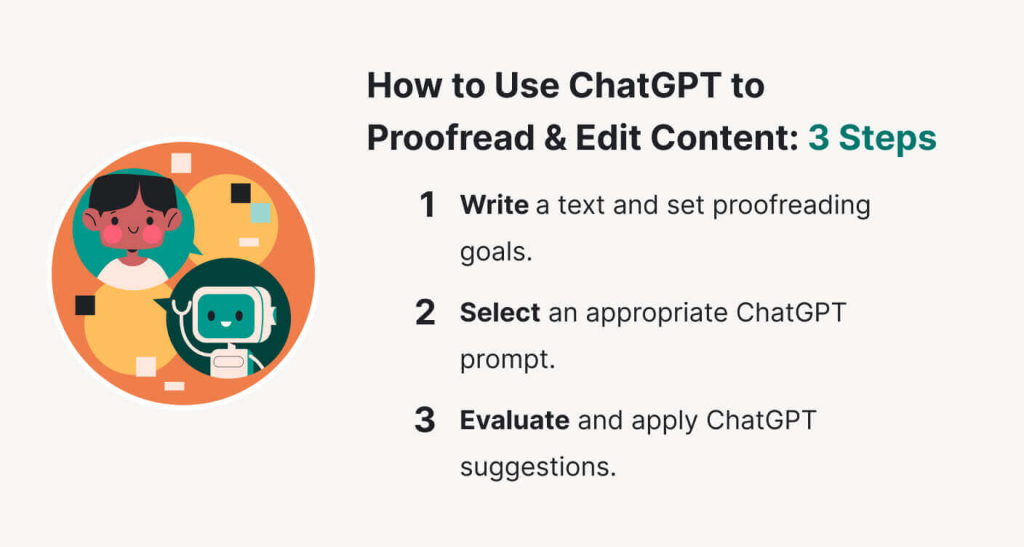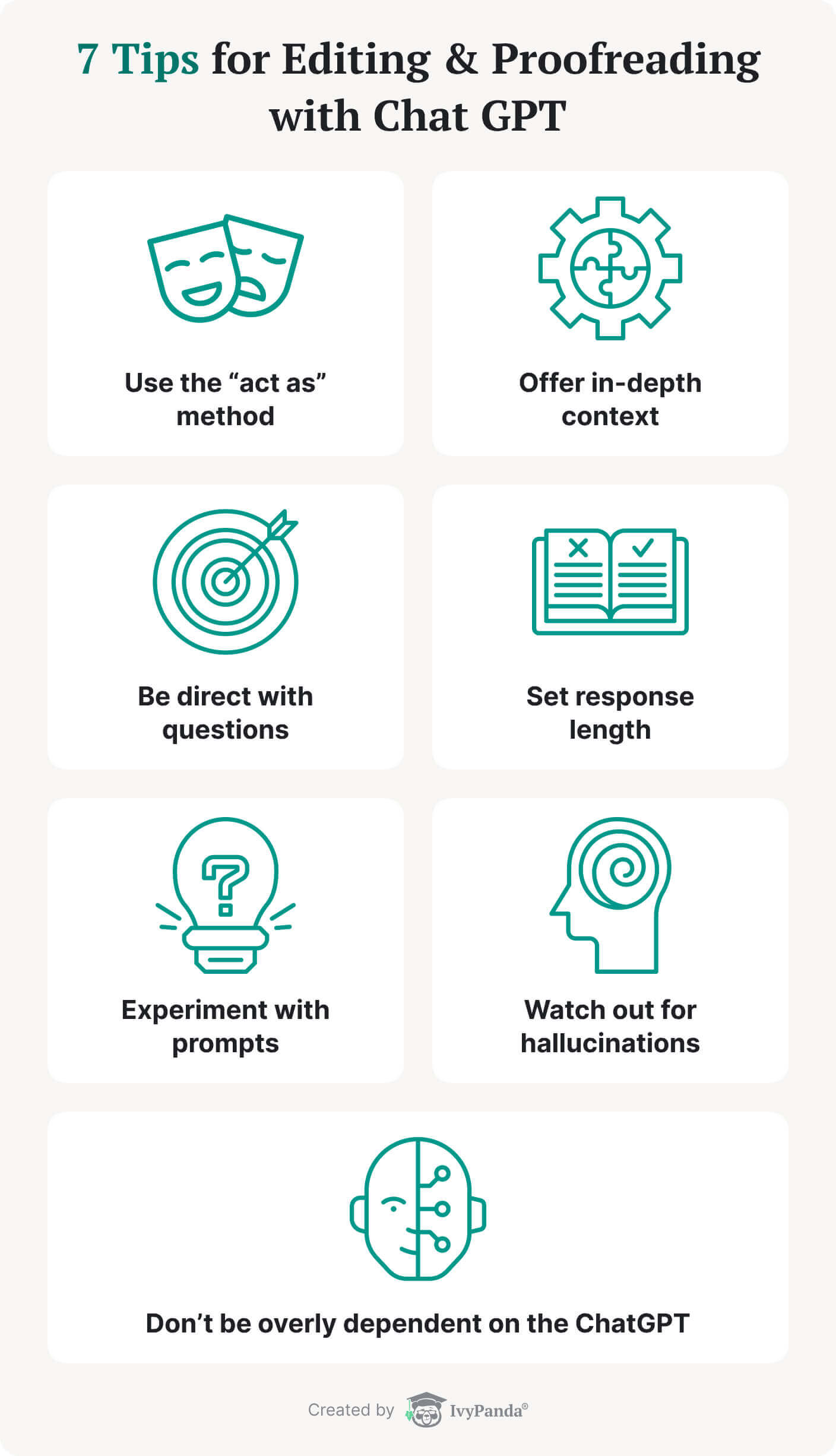Sometimes, you don’t have the time to carefully review and edit essays or articles. Your deadlines are getting closer, and you don’t have anyone to assist you in this task. Don’t worry – in this guide, we will give you an efficient solution to your challenges.
To save time on the editing process, you can simply use ChatGPT. Our team has explained how to build prompts so that the chatbot will check your university assignments like a pro. Trust our experience, and you will be able to edit your essay using AI no worse than a human editor.
Let’s get into it!
🤖 How Does ChatGPT Work?
ChatGPT is an AI-based chatbot that answers user requests by accessing vast knowledge databases on different subjects such as history, marketing, biology, the arts, and more. You ask the chatbot questions like “How many sonnets did Shakespeare write?” and it responds to the best of its ability.
The versatility of applications makes ChatGPT a particularly remarkable tool. Thanks to its promptness and convenience, many students use the chatbot for research. In addition to providing AI-generated content, the platform can adjust to individual formats and styles. These features are made possible thanks to deep learning training that allows ChatGPT to understand and process text input, providing human-like, natural responses. Using the tool is like talking to an expert on different subjects.

While many educators consider ChatGPT a form of cheating, this couldn’t be farther from the truth. Of course, word-for-word copy-pasting of produced text can be regarded as such, but in this article, we offer a safe method of using this chatbot for your academic integrity.
🤔 Can Chat GPT Edit Essays?
The short answer is yes, but there are a few nuances. This platform only supports surface editing and for certain types of documents. AI algorithms allow the chatbot to autocorrect mistakes and perform spell checks. ChatGPT can find missing punctuation marks, misspellings, and typos in relatively short texts intended for the general audience.
However:
You can always use other AI editing tools if you haven’t found a solution with ChatGPT.
Here are the best use cases for the chatbot:
- Simple social media posts that are easy to review.
- Emails to professors or colleagues with a broad context and short length.
- Technical writing for things like instruction manuals.
- Drafts of resumes, admission essays, and other works that are revised later.
- Short essays and articles that are less prone to redundancy.
- Less important informal documents.
Pros & Cons of Editing with ChatGPT
Below, you will find out more about what you can expect from ChatGPT capabilities. We’ve described the main benefits and drawbacks of this tool.
🕹️ Can ChatGPT Proofread & Edit: How It Works
Unlike some other editing assistants, ChatGPT will relatively easily improve your writing skills.

You must complete a few steps to proofread and edit your essay or article:
- Write a text and set proofreading goals. First, finish the text that requires proofreading, whether a college-level essay, an article, a research paper, or a blog post. At this point, it’s crucial to establish the editing goal: grammar use, punctuation, or finding the right tone and voice. If you need assistance with those, we have a great essay maker.
- Select an appropriate ChatGPT prompt. Next, choose the right prompt and provide it to the AI chatbot. Prompts are instructions the chatbot uses to produce a response. ChatGPT can improve sentence structure, clear up punctuation errors, or make the style and formatting consistent using these instructions.
- Evaluate and apply ChatGPT suggestions. After you’ve submitted the prompt, this tool will take some time to provide a text edit. Analyze suggested changes and check the document for factual mistakes and inconsistencies. Finally, assess how well the chatbot comprehends the text context before using any changes. Additionally, you can use our efficient GPT Essay Checker to polish your work.
🌟 Best Prompts for Chat GPT Editor
Here, we’ve gathered tasks that ChatGPT handles effortlessly and accurately. The following efficient ChatGPT prompts can significantly improve the structure and content of college essays, research papers, and other academic works. Carefully studying this approach saves time and optimizes the process of making high-quality texts. Select the most relevant task and find out for yourself!

ChatGPT Prompts to Check Text for Spelling Mistakes and Typos
The AI chatbot easily handles typos and spelling mistakes, just like Grammarly and tools embedded in Microsoft Word and Google Drive Documents. This approach lets writers correct their texts with minimum manual edits.
Here are several prompts you can use for this purpose:
- Proofread this [sentence/paragraph] for spelling mistakes: [text].
- Check this [document type] for spelling errors and typos: [text].
- Could you review this [article/essay] for spelling errors and correct them?: [text].
- Verify the spelling in this [document] and suggest improvements: [text].
- Check for typos in the [article/assignment] and provide corrections: [text].
- Please review this [essay/article] for grammatical and punctuation errors: [text].
- Ensure there are no spelling mistakes in the [article/document]: [text].
AI Editing Example: Spelling Mistakes
As you can see from our example, the chatbot recognized all grammatical errors and typos. You can confidently use such edited text in your paper.
ChatGPT Prompts to Check Sentence Clarity
The chatbot can change the structure of a sentence to make it clearer and more consistent with the style of the piece. This includes length adjustment, hook and content addition, and adaptation of the text for different styles. It’s beneficial when ironing out the introductions and conclusions of essays. If you need assistance with writing a hook, you can always try our handy hook generator.
Check out these effective prompts:
- Simplify and enhance the clarity of this [work]: [file/link].
- Rewrite the [text] for better sentence clarity.
- Clarify the meaning of this [sentence/paragraph].
- Help me rephrase this [sentence/phrase] for more clarity.
- Please review this [document] and suggest improving the sentence clarity: [content].
- Make the language in this [essay/article] more concise and clear: [text].
- Review this [work] and ensure all sentences have clarity and brevity: [file/link].
AI Editing Example: Sentence Clarity
In the rephrased version, ChatGPT broke down the main points into separate sentences and used more straightforward language. The new version emphasizes the urgency and consequence of action or inaction. Also, the chatbot removed some colloquial language to enhance text formality.
ChatGPT Prompts to Change Word Choice
ChatGPT helps find suitable alternative phrases and synonyms. These adjustments often make homework assignments more vibrant and engaging. You can also use the following prompts for your subsequent assignments. However, our platform has a good paraphrasing tool you can also utilize.
Here are some prompt ideas:
- Review this [document] for repetitive words and offer alternatives: [file/link].
- Provide better word choices for the following [sentence/paragraph]: [text].
- Help me find better words for this [paragraph] to make it more precise: [file/link].
- I need help replacing technical jargon with common vocabulary in this [research paper/article]: [text].
- Suggest language improvements for this [article/assignment] to make it more professional: [file/link].
- Analyze this [article/research paper] and propose adequate words for its target audience: [file/link].
- Review this [article/essay] and recommend more impactful words: [text].
AI Editing Example: Word Choice
In the new version, the chatbot suggested a few edits to make the paragraph more catchy. It added such emphases as “yielded remarkably profound outcomes” and “harnessing” to convey a stronger impression of the benefits of nuclear energy.
ChatGPT Prompts to Change Citation Style
When working on texts, students may use the wrong quotation style. ChatGPT can quickly edit and reformat texts into APA, MLA, and other formats. We also have a great citation maker that provides Harvard, Chicago and other styles.
The following prompts will help speed up this process:
- Assess if [article/essay] follows the MLA format and make appropriate adjustments: [text].
- Change the format of this [work] from [style] to [style]: [file/link].
- Evaluate and edit the bibliography of this [assignment] in accordance with [style]: [text].
- Please reformat this [work] using the [style] guidelines: [file/link].
- Check the correct use of [style] in this [article/paper]: [text].
- Create a bibliography for this [paper type] following the [style]: [file/link].
- Review the correctness of [style] use in this [work]: [file/link].
AI Editing Example: Citation Style
As you can see:
ChatGPT got the task and successfully changed the citation style from APA to Chicago. So you probably won’t have any problems with such a prompt. To be more certain, you can always provide a chatbot with guidelines from your institution. Besides, note that the chatbot has trouble citing the content it generates.
ChatGPT Prompts to Check and Remove Redundancy
This chatbot platform can be used to clear filler and redundant words. They don’t add any weight to the work and only increase the word count.
Here are several prompts students can use to improve their academic work:
- Remove or replace words that are used too much in this [work type]: [text]
- Remove repetitive words in this [document]: [work].
- Could you review this [paper/essay] and remove any reparative words and phrases?: [text].
- Review this [text] and make suggestions for the following [words]: [file/link].
- Please create an alternative for the [word] used in this [sentence/paragraph].
- Find and remove redundant information from [work]: [text].
- Use synonyms for the [word] in this [essay/paper]: [file/link].
AI Editing Example: Removing Redundancies
As we expected, the chatbot succeeded in finding both redundancy words and less obvious redundant wording problems.
ChatGPT Prompts to Improve Text Readability
OpenAI’s platform quickly edits information structures in essays and articles. For example, you can replace paragraphs in chronological order for better narrative flow and comprehension.
We’ve listed several effective prompts to improve text readability below.
- Identify [overused words/technical jargon] in the [essay/paper] and offer advice on making the work more readable.
- Examine the [assignment] for coherence and readability. Offer guidance on how to improve its narrative flow and readability.
- Evaluate the [academic paper] or readability concerning [paragraph length/sentence structure]. Make suggestions for better academic engagement.
- Assess the [work] for readability and offer ways of making it more accessible for [target audience].
- Utilize [method] to establish the clarity of the [work]. Explain how it can be made easier to follow.
- Review the [paper/essay] regarding flow and readability. Offer practical insights into improving its coherence.
- Assess the [work] using [Coleman-Liau index]. Make the text concise and clear by offering revisions.
AI Editing Example: Readability
After AI revision, the paragraph maintains the vivid imagery of the sunny day while seamlessly integrating the moment of realization about the iron. The ChatGPT used transitional phrases like “suddenly remembered” and “panic surged through me” to make the flow more cohesive.
ChatGPT Prompts to Check Punctuation
Students don’t always get the nuances of punctuation right, leading to mistakes that alter the meaning of sentences. ChatGPT helps you edit assignments quickly due to its in-depth knowledge of English.
To speed up this process, you may use the following prompts next time:
- Evaluate the use of colons in the following section: [section], ensuring that they effectively introduce explanations and lists.
- Assess the use of punctuation in the following [sentence/paragraph] to ensure that it’s easy to follow and properly structured.
- Add hyphens where necessary in this [sentence] to maintain proper use of adjectives and consistency.
- Check the proper use of the apostrophe in this [phrase] for an accurate indication of contraction or possession.
- Review ellipses in the following [paragraph] to ensure their appropriate use for omissions and emphasis.
- Change the placement of quotation marks in this [document] for proper direct speech attribution and quotation.
- Assess the end punctuation and capitalization in this [paragraph] and if they follow the standard writing practices.
AI Editing Example: Punctuation
ChatGPT added a comma after “friends” to clarify that the speaker addresses two people. Also, it removed the unnecessary commas before “or.” Now, the sentences are written correctly.
ChatGPT Prompts to Change Passive Voice Into Active Voice
Works using the active voice are more direct and more accessible to follow. However, student writing doesn’t always have the correct form of verbs, leading to confusion and poorly structured papers. OpenAI’s platform can transform sentences from passive voice to active in mere seconds.
Check out the prompts:
- Rewrite the following [paragraph/sentence] in active voice.
- Transform this [sentence] to improve reader engagement and readability.
- Modify the [sentence] through active voice to give a sense of accountability.
- Restructure the [sentence/segment] in an active voice to make it more energetic and concise.
- Change the passive voice in [sentence] to active, giving action to a specific subject.
- Convert this [paragraph] in the active voice to make it more straightforward.
- Edit the [sentence] using active voice for better directness and clarity.
AI Editing Example: Eliminating Passive Voice
Here, we wanted to show how the chatbot copes with changing the text written in the passive to the active one. In this case, ChatGPT also showed itself favorably.
ChatGPT Prompts to Change Text Tone
You may accidentally switch from one voice to another when working on several academic tasks. An AI chatbot can add more formal-sounding phrases into conversational texts and vice versa.
Use the following ChatGPT prompts to keep the text tone consistent.
- Assess the [work]’s tone and establish if it follows an academic writing style.
- Evaluate this [article/paper] and see if it has a consistent tone: [text].
- Please establish if this [paragraph/segment] follows the overall tone of this [work].
- Edit the [document] and ensure that its tone is formal: [file/link].
- Establish if the tone of this [paper/essay] is appropriate for the [target audience].
- Could you help me edit this [work] to follow an informal tone?
- Evaluate if this [assignment] has a formal tone and structure: [file/link].
AI Editing Example: Text Tone
You can see that the second edited version looks ready to be used in a study. The paragraph looks more professional, with a formal tone and a better language choice.
ChatGPT Prompts to Check Tense Usage
OpenAI’s platform streamlines changing tenses and ensures the text follows the same one. For example, research papers are primarily written in the past tense, while the present tense is used in discussing current events.
The following ChatGPT prompts will make this process more approachable for you.
- Cross-reference the [introduction/conclusion] with the main body of this [thesis/research paper] for [consistent tense]: [introduction/conclusion]
- Ensure the [verbs/verb phrases] in the [document] are in [past/present/future] tense for consistency: [verbs/verb phrases and tense]
- Please check if this work has a [consistent tense] when writing about [actions/events] in this [essay/paper]: [insert consistent tense and events/actions].
- Review this [essay/paper] and ensure there’s a [consistent tense]: [paper/essay and tense].
- Assess this [document] for any sudden shifts in tense and edit to maintain a [consistent] writing style: [file/document].
- Examine the [events/timeline] in this [document] to ensure its narration has a [consistent tense]: [document and tense].
- Evaluate this [research paper] and ensure that all verbs are used in [consistent tense]: [paper/tense].
AI Editing Example: Using Tenses
Our example proves that AI can handle such a challenge. ChatGPT changed “we’ve analyzed” to “we analyzed” to match the past tense used in the subsequent sentences.
ChatGPT Prompts to Check Grammar
Grammar check is a strictly technical procedure that should be left until you’ve corrected the work’s format, tone, and style.
Below, we’ve listed several prompts you can use when working with ChatGPT.
- Did I use the right grammar in this [sentence/phrase]?: [text].
- Proofread the [document] and correct grammatical mistakes: [text].
- Please check the correct use of grammar in this paragraph: [file/link].
- Evaluate this [paper/essay], find and correct grammatical mistakes: [text].
- Review the use of grammar in this [document] and correct any mistakes: [document]
- Assess the grammar in [essay/paper] and make necessary connections: [file/link].
- Could you check grammar in this [assignment]?: [text].
AI Editing Example: Checking Grammar
The initial version of the text was far from perfect, but the chatbot improved the situation. It helped us with tenses, punctuation, and choosing the proper phrasing.
🪄 AI Revision Tips for Editing & Proofreading with Chat GPT
Finally, we’ve prepared some helpful tips to make your chatbot experience more successful and enjoyable. Check them out and try them the next time you need ChatGPT for document editing.

Here are the tips:
- Use the “act as” method. Address ChatGPT like someone you’d ask for help. An AI conversation can start like this: “Act as a professional proofreader. How would you improve the grammar in this text?”. Such an approach will make the chatbot produce more accurate results.
- Offer in-depth context. Provide enough contextual information for ChatGPT to understand your requests’ requirements better. You can combine your questions with well-tailored prompts to ensure better outcomes. Remember that if you are researching with ChatGPT, you should check the credibility of the data.
- Be direct with questions. After you get an answer, don’t forget to ask follow-up questions. For example, ask ChatGPT why it decided to make specific changes to the text in terms of sentence structure or passive voice use.
- Set response length. When requesting the chatbot to write edits, limit the number of paragraphs, sentences, and words you want to see in the responses. It’s also possible to ask the chat for sentence-by-sentence comparisons of original and edited works. If you have a long essay, you can learn about it in the article on how to work with such content using ChatGPT.
- Experiment with the chatbot. Don’t be afraid to write a request in different ways. This will let you see which prompts provide the best results.
- Remember about hallucinations. While ChatGPT is highly versatile and accurate, it doesn’t always provide relevant and sensible results. For example, it can offer grammatical corrections when none are needed or give nonsensical suggestions.
- Don’t be overly dependent on the chatbot. Finally, it’s important to remember that ChatGPT doesn’t replace the human experience when it comes to evaluating written works. After you’ve finished adding the chatbot-generated content, review the document several times until everything feels right and aligns with your writing style. This way, you’ll also avoid AI detection from review tools that recognize ChatGPT’s work.
ChatGPT has the power to improve academic work in different ways. But, it’s vital to remember its limitations and check the writing yourself. We hope our prompt examples will make the chatbot an excellent aid and ease the editing process. Our team also invites you to check out our beneficial article on how to use ChatGPT for essay writing.
🔗 References
- ChatGPT: Everything You Really Need To Know (In Simple Terms). – Bernard Marr, Forbes
- ChatGPT Is my Writing Coach and Editor: Here’s How. – Nathan Laundry, Medium
- How You Should—and Shouldn’t—use ChatGPT as a Student. – Open Universities Australia
- Generative AI in Academic Writing. – The University of North Carolina at Chapel Hill
- 8 ChatGPT Prompts for Perfect Proofreading. – Prompt Advance
- Editing ChatGPT Outputs: 4 Essential Tips and Prompt Approaches. – Liam Berry, Industry Dive
- How to (Productively) Edit Your Writing with ChatGPT. – Dickie Bush and Nicolas Cole, Write With AI
- 11 Unique ChatGPT Prompts for Proofreading in 2024. – GeeksforGeeks, Sanchhaya Education
- How to Get ChatGPT to Edit Its Own Work. – Ralph Grayden, Linkedin
- Using ChatGPT and Other Text-Generating Artificial Intelligence (GenAI). – University of Waterloo



![187 Impressive Higher English Persuasive Essay Topics [2026]](https://ivypanda.com/blog/wp-content/uploads/2020/10/front-view-of-books-with-blue-background-309x208.jpg)